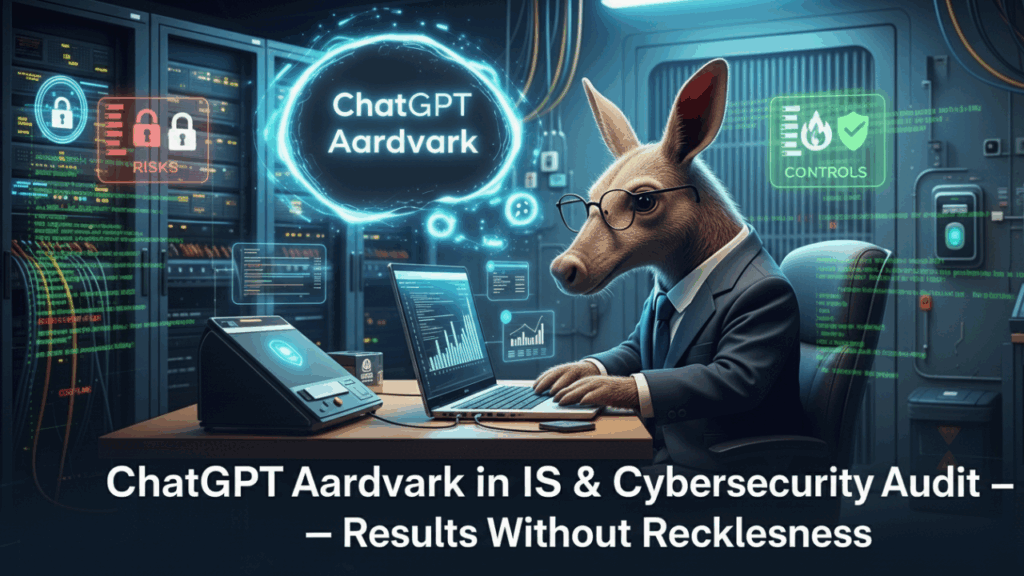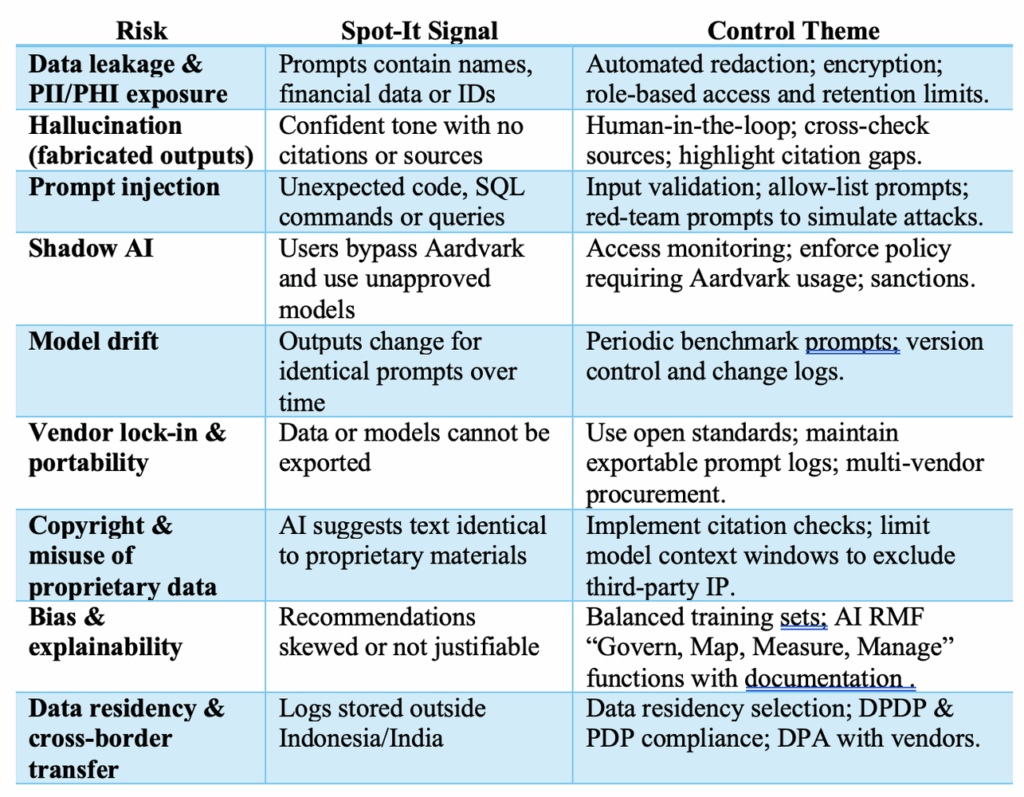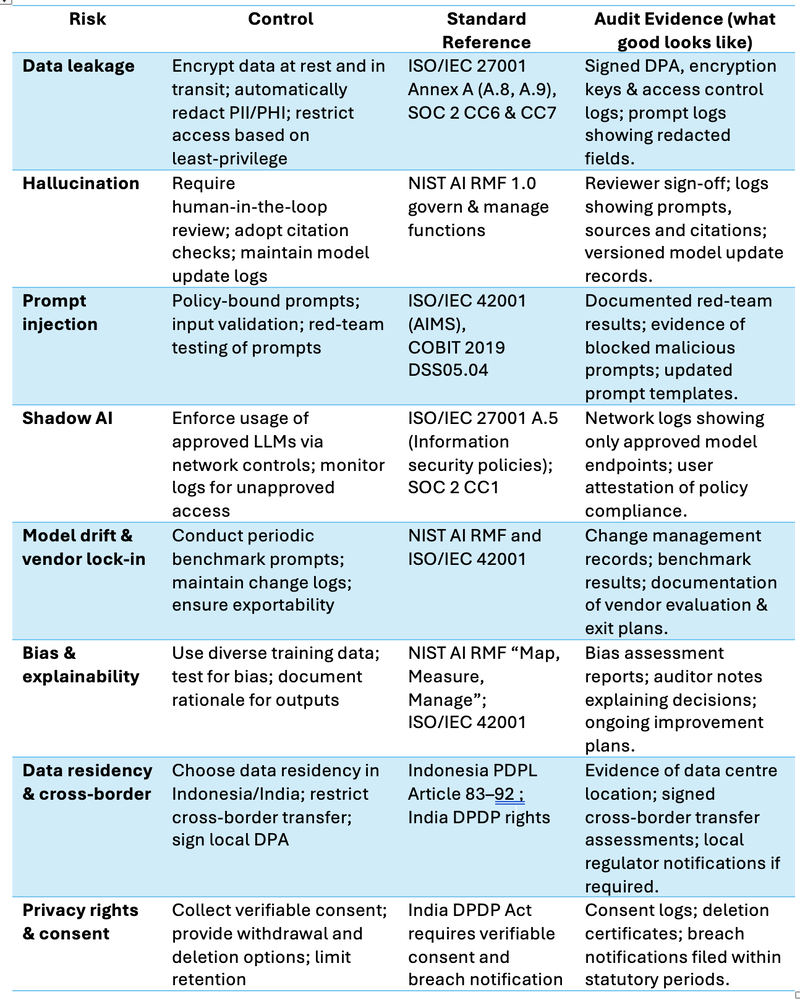


Speed without controls is just expedited non‑compliance. In a world where financial closings are compressed and cyber threats don’t sleep, the promise of AI in internal audit is intoxicating. But if “move fast and break things” becomes your audit motto, you’re signing up for regulatory fines and board scrutiny. The smarter approach is to harness ChatGPT Aardvark — a secure, policy‑bound AI layer built for audit workflows — to deliver faster results without recklessness.
– 30–40 % faster test design by auto‑drafting test procedures aligned to control objectives and standards.
– 20–30 % reduction in rework via policy‑bound prompts and AI‑driven drafting that catch inconsistencies early.
– >90 % evidence traceability because ChatGPT Aardvark logs every prompt, redaction and citation.
– 15–25 % audit coverage uplift by surfacing hidden risks and suggesting sampling logic beyond human intuition.
– 10–15 % cost reduction through automated scoping, control mapping and report drafting.
Also Read :
ESG 101: Why Sustainable Business Setup is the Future of Indonesia Investment
Indonesia Tax Compliance Calendar 2025
Annual Tax Return for Indonesian SMEs in 2025: Complete Filing Guide with Coretax System
– Prompt injection → input validation, secure prompt templates and red‑team testing.
– Hallucination → human‑in‑the‑loop review with citation checks.
– Data leakage & PII/PHI → automated redaction, encryption and strict role‑based access.
– Model drift and vendor lock‑in → periodic benchmark prompts, change logs and multi‑model procurement.
– Bias & explainability → standardized prompts aligned to NIST AI RMF and ISO 42001, with reviewer sign‑offs.
ChatGPT Aardvark is not the public ChatGPT you’ve tried at home; it’s an enterprise‑grade deployment tailored for audit and cybersecurity functions. Think of it as a policy‑enforced LLM layer sitting between your auditors and the foundational model. Key components include:
– Policy‑bound prompt templates that force each query to reference an approved audit policy, standard or control objective. Prompts are tagged, classified and stored.
– Automated redaction for PII/PHI; sensitive fields in prompts and responses are masked before the model sees them.
– Prompt/response logging & retention controls ensuring evidence chains are preserved. The NIST AI Risk Management Framework emphasises that AI tools should improve trustworthiness throughout design, development and evaluation .
– Data residency selection so data can stay within Indonesian or Indian jurisdiction to comply with local privacy laws; logs can be stored on‑premises or in approved clouds.
– Role‑based access with least‑privilege: auditors, QA reviewers, prompt librarians and administrators have distinct capabilities.
– Evidence export and DPA & model update logs — if the underlying model changes, Aardvark records when, why and how. This aligns with ISO/IEC 42001:2023, which specifies that an AI management system must “establish, implement, maintain, and continually improve” AI processes and balance innovation with governance .
Aardvark differs from consumer LLMs by embedding governance and auditability into its architecture. It forces policy compliance (ISO/IEC 27001 Annex A controls, SOC 2 CC series, COBIT 2019), logs every interaction and supports “AI management” per ISO/IEC 42001 . This is crucial when handling regulated data or evidence.
Audit functions face backlogs, shrinking budgets and talent shortages while stakeholder expectations rise. SOX/ICFR demands, the shift to ISO‑27001:2022’s 93 controls grouped into people, organisational, technology and physical categories , and rising cyber‑attack volumes make manual approaches unsustainable. ChatGPT Aardvark fills the gap by accelerating:
– Scoping accelerators & risk hypotheses: Use policy‑bound prompts to suggest risk scenarios based on industry, process and regulatory scope.
– Test‑step generation aligned to control objectives: Generate test procedures that map to ISO 27001 Annex A control categories or COBIT 2019, reducing design time.
– Sampling logic & coverage rationale: Suggest statistical sampling, risk‑based stratification and document the rationale.
– Control catalogue drafting & mapping: Draft control descriptions and map them to ISO 27001, SOC 2, NIST AI RMF and regulatory clauses.
– Security flaw detection support: Generate triage narratives and potential exploit paths based on vulnerability feeds; propose compensating controls.
– Vulnerability prioritisation: Rank findings by business impact, exploitability and compensating controls, integrating with CVE databases.
– Preventing security issues on the go: Inline secure‑prompt hints block queries containing secrets or credentials; policy gates stop unauthorized data exfiltration.
– Evidence summarisation & traceable citations: Summarise logs, extract key evidence and attach citations from authoritative sources.
– Report drafting with caveats and reviewer gates: Draft audit reports, flag limitations, and require QA reviewers to approve before finalization.
– Detecting logic flaws & privacy issues: Beyond security, Aardvark flags broken business rules (e.g., mismatch between purchase order and goods received) and privacy gaps (excessive data capture or missing consent).
Mini‑case (anonymized): A manufacturing client’s procure‑to‑pay (P2P) audit used ChatGPT Aardvark for scoping and sampling. By feeding process maps and risk registers into Aardvark’s prompt library, the team cut scoping time by 35 % and improved sample quality scores by 18 % (measured by duplicate detection and error rates). AI‑generated test steps were reviewed by a human QA reviewer and saved ~200 person‑hours.


Indonesia: PDP Law No. 27/2022
The Personal Data Protection Law (PDPL) applies extraterritorially: any entity processing data of Indonesian citizens, even outside Indonesia, is subject to its requirements. It emphasizes limited and transparent data collection, accuracy, security measures and gives a two‑year compliance transition . Cross‑border transfer provisions require that the recipient country have equivalent or higher data protection; otherwise, the controller must obtain explicit consent from the data subject . Data subjects have broad rights (access, rectification, deletion, withdrawal of consent, objection to automated decisions) . Controllers and processors must protect personal data and ensure confidentiality, integrity and accountability .
India: Digital Personal Data Protection Act 2023
The DPDP Act grants data principals the right to give or withdraw consent, access their personal data, rectify or erase it and obtain grievance redressal . Data fiduciaries must request and obtain verifiable consent from each data principal and specify the purpose and type of data they will process . They must notify data subjects how to withdraw consent and how to file a complaint . Fiduciaries are required to ensure data accuracy, implement organizational and technical measures to secure personal data, conduct audits, notify affected individuals and regulators of breaches and destroy personal data upon withdrawal of consent unless retention is required by law . Significant data fiduciaries must appoint an in‑country Data Protection Officer and independent data auditors .
– Hosting model & data residency: Where will prompts and logs reside? Are there local data centre options for Indonesia and India?
– Redaction/masking features: Does the platform automatically redact PII/PHI before processing?
– Retention & deletion controls: Can you set retention periods and enforce secure deletion?
– Red‑team/testing cadence: How often does the vendor test for prompt injection and model bypass?
– Incident SLAs: What are the response times for breaches?
– Sub‑processor transparency: Are all sub‑processors disclosed, and are DPAs in place?
– Certifications: ISO 27001, SOC 2, ISO/IEC 42001, and local certifications (e.g., BSSN in Indonesia).
– Audit rights: Can you audit the vendor’s controls and review logs?
– Model update notes: Do you receive notice before model updates or training data changes?
– Logging & export: Are logs tamper‑evident and exportable for regulators?
Roles & responsibilities
– Prompt Librarian (Responsible): Curates approved prompt templates, tags them with control objectives and regulatory references, and updates redaction rules.
– Model Risk Owner (Accountable): Owns the risk register for ChatGPT Aardvark usage, approves model updates, monitors bias and drift, and reports to the Audit Committee.
– Data Protection Officer (Support): Ensures compliance with PDP/DPDP laws, reviews DPA terms and oversees cross‑border transfers.
– QA Reviewer (Consulted): Reviews AI‑generated outputs, performs evidence checks and ensures citations align with authoritative sources.
– Engagement Manager (Responsible): Uses Aardvark during engagements, monitors metrics and escalates issues.
– Tooling Admin (Informed): Manages access control, logging infrastructure and integrates Aardvark with existing tools.
Auditors love numbers. To justify adoption and sustain executive support, track the following metrics:
– Cycle‑time: Days from scoping to report issuance; target 20 % reduction.
– Test coverage %: Percentage of risk areas addressed relative to the audit universe; aim for >90 % coverage using AI‑driven hypotheses.
– Defect density: Number of findings per 1 000 control tests; measure how AI influences risk discovery quality.
– Rework %: Portion of AI‑generated outputs requiring significant edits; decreasing rework signals improved prompt engineering.
– False‑positive rate: For security scans or control violation alerts; track and tune AI parameters.
– Leakage incidents: Number of unredacted PII/PHI exposures; zero tolerance, monitor via redaction logs.
– Cost per engagement: Compare AI‑enabled engagements with traditional ones; highlight cost savings.
– Adoption/enablement: Percentage of team using ChatGPT Aardvark, training completion, prompt library utilisation.
Tie these metrics to executive outcomes: faster close cycles mean better working capital management; higher coverage reduces risk of control failures; fewer false positives free up team time; and compliance with data protection laws avoids fines.
– 30 days: Draft an AI policy aligned to ISO 27001 and NIST AI RMF; develop secure prompt templates; conduct a red‑team exercise for prompt injection; set classification rules (public, confidential, PII/PHI); embed privacy‑by‑design guardrails.
– 60 days: Map risks to controls and embed control checks into audit workflows; sign Data Processing Agreements with vendors; enable evidence logging; roll out user training and reviewer checklists; integrate with ticketing systems.
– 90 days: Pilot three audits (mix of information systems and process audits such as O2C, P2P and ITGC); measure KPIs (cycle‑time reduction, coverage uplift, rework %); present results to the Model Risk Management (MRM) committee or Audit Committee; plan scaling across functions and continuous improvement.
If your audit team treats AI like an unsupervised intern, don’t be surprised when it shows up at the board meeting wearing flip‑flops. ChatGPT Aardvarkoffers a far better option: a secure, policy‑bound co‑pilot that can accelerate internal audit and cybersecurity audit without compromising compliance. As a cross‑border advisor operating between Indonesia and India, my mission is to help you adopt AI responsibly. Share your toughest AI‑in‑audit question in the comments; let’s crowdsource solutions.
Disclaimer: This article provides general guidance and does not constitute legal advice.

Situs Pasti Scam Indonesia, BOKEP JAPAN KONTOL KAU
It’s refreshing to find something that feels honest and genuinely useful. Thanks for sharing your knowledge in such a clear way.
This topic really needed to be talked about. Thank you.
This content is really helpful, especially for beginners like me.
I wasn’t expecting to learn so much from this post!
Your articles always leave me thinking.
I agree with your point of view and found this very insightful.
It’s refreshing to find something that feels honest and genuinely useful. Thanks for sharing your knowledge in such a clear way.
Great job simplifying something so complex.
Keep writing! Your content is always so helpful.
Great job simplifying something so complex.
I feel more confident tackling this now, thanks to you.
This gave me a whole new perspective. Thanks for opening my eyes.
This was incredibly useful and well written.
What I really liked is how easy this was to follow. Even for someone who’s not super tech-savvy, it made perfect sense.
I love the clarity in your writing.
This content is gold. Thank you so much!
You’ve clearly done your research, and it shows.
Your thoughts are always so well-organized and presented.
Thanks for addressing this topic—it’s so important.
You really know how to connect with your readers.
Your breakdown of the topic is so well thought out.
You’ve clearly done your research, and it shows.
I appreciate your unique perspective on this.
What an engaging read! You kept me hooked from start to finish.
You write with so much clarity and confidence. Impressive!
Good read — the key takeaways were especially helpful.
I learned something new today. Appreciate your work!
I feel more confident tackling this now, thanks to you.
Great job simplifying something so complex.
This was really well done. I can tell a lot of thought went into making it clear and user-friendly. Keep up the good work!
This post gave me a new perspective I hadn’t considered.
Your advice is exactly what I needed right now.
I hadn’t considered this angle before. It’s refreshing!
I’ve read similar posts, but yours stood out for its clarity.
I wasn’t expecting to learn so much from this post!
This topic really needed to be talked about. Thank you.
You clearly know your stuff. Great job on this article.
I wish I had read this sooner!
Your passion for the topic really shines through.
The way you write feels personal and authentic.
Your tone is friendly and informative — made for an enjoyable read.
Thank you for putting this in a way that anyone can understand.
I never thought about it that way before. Great insight!
Excellent work! Looking forward to future posts.
Such a simple yet powerful message. Thanks for this.
Great information shared.. really enjoyed reading this post thank you author for sharing this post .. appreciated
I love how practical and realistic your tips are.
Thank you for making this topic less intimidating.
There is definately a lot to find out about this subject. I like all the points you made
You really know how to connect with your readers.
I’ve read similar posts, but yours stood out for its clarity.
This speaks truth
Thank you for offering such practical guidance.
I love how well-organized and detailed this post is.
Keep educating and inspiring others with posts like this.
Your content always adds value to my day.
Thank you for offering such practical guidance.
Very relevant and timely content. Appreciate you sharing this.
You made some excellent points here. Well done!
This gave me a lot to think about. Thanks for sharing.
Your writing always inspires me to learn more.
Your passion for the topic really shines through.
Thanks for addressing this topic—it’s so important.
Your thoughts are always so well-organized and presented.
This helped clarify a lot of questions I had.
Great post! I’m going to share this with a friend.
I love the clarity in your writing.
Great post! I’m going to share this with a friend.
You clearly know your stuff. Great job on this article.
Such a thoughtful and well-researched piece. Thank you.
You’re doing a fantastic job with this blog.
You made some excellent points here. Well done!
Very useful tips! I’m excited to implement them soon.
Very useful tips! I’m excited to implement them soon.
The way you write feels personal and authentic.
Thank you for being so generous with your knowledge.
This content is really helpful, especially for beginners like me.
I never thought about it that way before. Great insight!
I never thought about it that way before. Great insight!
It’s great to see someone explain this so clearly.
Thank you for offering such practical guidance.
Keep writing! Your content is always so helpful.
Thanks for addressing this topic—it’s so important.
This was incredibly useful and well written.
You’ve done a great job with this. I ended up learning something new without even realizing it—very smooth writing!
This gave me a whole new perspective. Thanks for opening my eyes.
What I really liked is how easy this was to follow. Even for someone who’s not super tech-savvy, it made perfect sense.
I enjoyed your take on this subject. Keep writing!
What a helpful and well-structured post. Thanks a lot!
I appreciate how genuine your writing feels. Thanks for sharing.
Excellent work! Looking forward to future posts.
You’re doing a fantastic job with this blog.
You’ve done a great job with this. I ended up learning something new without even realizing it—very smooth writing!
Yemeklerin fiyatları çok uygun, porsiyonlar ise oldukça doyurucu. Kavurma ve yanındaki pilavla mükemmel bir öğün geçirdim. Çalışanlar da son derece ilgili.
Your content always adds value to my day.
This was very well laid out and easy to follow.
I’ve bookmarked this post for future reference. Thanks again!
This was incredibly useful and well written.
Your passion for the topic really shines through.
Such a thoughtful and well-researched piece. Thank you.
You clearly know your stuff. Great job on this article.
You clearly know your stuff. Great job on this article.
This is one of the best explanations I’ve read on this topic.
I like how you presented both sides of the argument fairly.
I love the clarity in your writing.
I’ve read similar posts, but yours stood out for its clarity.
I’ll definitely come back and read more of your content.
Such a simple yet powerful message. Thanks for this.
I’ll definitely come back and read more of your content.
I’ve read similar posts, but yours stood out for its clarity.
I truly appreciate your technique of writing a blog. I added it to my bookmark site list and will
I hadn’t considered this angle before. It’s refreshing!
Pide siparişim kısa sürede geldi, taş fırından yeni çıkmıştı. Hamur ince, iç malzeme boldu. Rize’de bu kadar kaliteli bir pide yemek büyük keyif.
Excellent tips — I implemented a few and saw immediate improvement.
Nice guide — the tips are simple but effective. Thanks!
Your writing style is engaging and easy to follow. Keep it up!
Thanks for sharing your knowledge. This added a lot of value to my day.
Excellent work! Looking forward to future posts.
This was really well done. I can tell a lot of thought went into making it clear and user-friendly. Keep up the good work!
Thank you for making this topic less intimidating.
Love the way you explained this topic. (#547)
I feel more confident tackling this now, thanks to you.
What a helpful and well-structured post. Thanks a lot!
Awesome! Its genuinely remarkable post, I have got much clear idea regarding from this post
What a helpful and well-structured post. Thanks a lot!
I love the clarity in your writing.
Your writing always inspires me to learn more.
This article is well-researched and clearly written. Appreciate the effort!
You made some excellent points here. Well done!
Good read — the key takeaways were especially helpful.
Great topic and excellent execution. Subscribed for updates.
Get Lossless Scaling: The Ultimate FPS Booster for Any Game. https://ultrascale.surge.sh
Solid suggestions — would be great to see a downloadable checklist.
Thanks for making this easy to understand even without a background in it.
I appreciate the honesty and openness in your writing.
You made some excellent points here. Well done!
Ready to Unlock the Full Potential of Your PC? Get Lossless Scaling Now! https://ultrascale.netlify.app
This was exactly what I was searching for. Thanks a lot!
Pide siparişim kısa sürede geldi, taş fırından yeni çıkmıştı. Hamur ince, iç malzeme boldu. Rize’de bu kadar kaliteli bir pide yemek büyük keyif.
I always look forward to your posts. Keep it coming!
You bring a fresh voice to a well-covered topic.
Very readable and informative. Saved this for future reference.
Pide çeşitlerinin hepsini denemek istedim çünkü hepsi çok güzel görünüyordu. Özellikle kuşbaşılı pide favorim oldu, eti ve peyniri çok uyumluydu.
Tired of Stuttering? Lossless Scaling Provides Smooth Gameplay. https://ultrascale.surge.sh
I love the practical tips in this post. Can you recommend further reading?
Secure Your Download: Lossless Scaling is Available Here. https://ultrascale.netlify.app
Solid post — bookmarked and shared. Keep producing content like this!
Awesome write-up! The screenshots made everything so clear.
Website Scam Penipu Indonesia, situs pornhub SITUS SEXS
Website Scam Penipu Indonesia, situs xnxx SITUS SEXS
Improve Your Gaming Performance: Download Lossless Scaling Now. https://speedpc.netlify.app
Bahis Para Yatırma ve Çıkarma İşlemleri
Optimize Your Favorite Games: Download Lossless Scaling Today. https://freebacklinks.pythonanywhere.com
Such a thoughtful and well-researched piece. Thank you.
I’ve read similar posts, but yours stood out for its clarity.
I very delighted to find this internet site on bing, just what I was searching for as well saved to fav
Thank you for putting this in a way that anyone can understand.
I appreciate your unique perspective on this.
Download and See the Magic: Lossless Scaling. https://frameboost.netlify.app
Looking for the Ultimate FPS Booster? Download Lossless Scaling Today! https://speedpc.netlify.app
Thanks for making this easy to understand even without a background in it.
You’ve built a lot of trust through your consistency.
I appreciate how genuine your writing feels. Thanks for sharing.
Very useful tips! I’m excited to implement them soon.
Türkiye’de en çok tercih edilen bahis firmalarından biri olarak hizmetlerini sürdürüyor.
I enjoyed your perspective on this topic. Looking forward to more content.
It’s refreshing to find something that feels honest and genuinely useful. Thanks for sharing your knowledge in such a clear way.
Thank you for making this topic less intimidating.
So simple, yet so impactful. Well written!
Thanks for making this easy to understand even without a background in it.
Excellent work! Looking forward to future posts.
모유 양이 적은 것 같아 걱정했는데 수유량 기준 참고하니까 마음이 좀 놓였어요.
I like the efforts you have put in this, regards for all the great content.
수유 관련 정보 중에 가장 실용적이어서 앞으로도 계속 사용할 것 같습니다.
Download Lossless Scaling Now: Experience Gaming Like Never Before. https://speedpc.netlify.app
I just like the helpful information you provide in your articles
Well-written and insightful. Would love to see case studies next.
I’ve gained a much better understanding thanks to this post.
I’ve bookmarked this post for future reference. Thanks again!
You’ve built a lot of trust through your consistency.
Your thoughts are always so well-organized and presented.
I truly appreciate your technique of writing a blog. I added it to my bookmark site list and will
Thanks for addressing this topic—it’s so important.
This gave me a whole new perspective on something I thought I already understood. Great explanation and flow!
Is Your PC Holding You Back? Download Lossless Scaling! https://speedpc.netlify.app
I never thought about it this way before. Your post gave me a fresh perspective.
Keep writing! Your content is always so helpful.
What a helpful and well-structured post. Thanks a lot!
Very useful tips! I’m excited to implement them soon.
Posts like this are why I keep coming back. It’s rare to find content that’s simple, practical, and not full of fluff.
Frustrated with Lagging Games? Lossless Scaling is Here! https://speedpc.netlify.app
You did a great job with this explanation—thank you!
I like how you kept it informative without being too technical.
I wish I had read this sooner!
Unlock Smooth Gameplay: Download Lossless Scaling Today. https://ultrascale.surge.sh
Good post! We will be linking to this particularly great post on our site. Keep up the great writing
This was a great reminder for me. Thanks for posting.
I love how clearly you explained everything. Thanks for this.
Great mix of research and practical application. Very helpful.
Helpful and well-paced. Looking forward to your next post.
Website Scam Penipu Indonesia, situs porno situs scam
I didn’t expect this to be so informative, good job.
Website Scam Penipu Indonesia, situs penipu SITUS SEXS
Buddy social media makes connecting with people easier and fun.
Website Scam Penipu Indonesia, judi kontol anak lonte
I really like reading through a post that can make men and women think. Also, thank you for allowing me to comment!
I really like reading through a post that can make men and women think. Also, thank you for allowing me to comment!
A concise guide with practical steps — very helpful indeed.